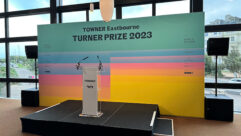TALL TALES FROM THE FIELD
Jan 1, 2002 12:00 PM,
By Jerry Rigg
ONE BUSY FRIDAY, I was in my office reviewing project cost reports, noting that a box of 8-32 trusshead machine screws had been attributed to the rack building portion of five projects and not to the ceiling speaker costs. (Very precise cost accounting is the secret to a successful contracting business.) The phone rang. My receptionist picked it up on precisely the third ring. (Don’t let people think you aren’t busy.) She transferred the call to a secretary who wasn’t in, so the caller could hear that we were a big company with voice mail. After the caller’s second call to get back to the receptionist, she transferred him to my office phone (though, really, the cellular would have been more impressive).
The caller was a new member of the sound system community. His tech-stock-wealthy father had just bought him a touring system with all the bells and whistles so that he could go into the highly profitable live-sound business. It was his first gig, and he was having a problem down at the local arena. Naturally, I couldn’t miss the opportunity to give a colleague a hand. I dropped what I was doing and took the next bus to the arena.
I arrived to find a loud hum in all parts of his sound system. I immediately explained to him how hum is always caused by magnetic fields inducing voltages in the shields of the audio cables. We disconnected all the shields, but there was still a hum. Although, now it was much closer to the new noise floor and pleasantly masked by a bit of a local radio station.
It was time for drastic action: a quick trip to the local mall’s electronics store for a 24-volt transformer, a line cord, a fuse (safety first!), a 100-ohm pot and a length of 18-gauge wire. Back at the arena, I taped the wire to the floor in a circle around the sound rack. I connected the transformer’s secondary through the pot to the coil on the floor. Powering up the transformer made the hum worse, so I flipped over the AC plug. I explained to my colleague that since there are only two possible phases of 60-cycle noise, the plug trick worked all the time. I then adjusted the pot to trim out the hum. The pot let out the normal bit of smoke and then settled in to its final value.
My new friend was so grateful that he gave me two free balcony passes to that evening’s performance.
LATER THAT NIGHT…
I arrived early because that was what the bus schedule allowed. It turned out to be a good thing: It was apparent at once that something was wrong. Looking through the darkened arena, I spotted my friend in a discussion with the promoter. Even at that distance, I could hear some comments about bovine excrement, sexual reproduction and electrical power.
A small fire had occurred when the arena’s Delta-to-Y converter failed as the lights were brought up for the light check. The promoter was afraid the concert would have to be canceled. “Not to worry!” I exclaimed. I asked my new friend if I could have a few of the walkie-talkies from his well-equipped, nattily dressed stagehands. He gave me several 5-watt units. I took my small tool kit out of my back pocket protector and disconnected the microphones and speakers from the units. I then connected the speaker output of the first unit to the microphone input of the second. I now had 25 watts, so I connected a third unit for 125 watts. By the fifth unit, I had 3125 watts. But my friend interjected, “Three thousand watts is not enough!” I dispatched two of the stagehands to find more walkie-talkies. They came back with two more units. Now we had 78,125 watts.
It was now starting time, and the crowd was getting anxious. My friend exclaimed, “Great! That’s the sound, but what about the lights?”
I took two of his 3000-watt woofers and wired them in series. Unfortunately, I had underestimated the resulting power. As the first lights were connected, they blew out instantly — the 9 million watts were too much. With my new friend running the dimmer board, we carefully connected the remaining lights. It worked well with the additional effect of the lighting being modulated by the crowd noise. The show started only fifteen minutes late.
AND ON THE MORROW…
The next morning, I noticed a headline in the paper: “Show SAVED by Local Man.” I was quite surprised, as the press rarely covers such technical events. However, as I read on, I learned that a local plumber had attended last night’s affair and noticed the crowd becoming agitated when the show was delayed. He borrowed a watch from the person seated next to him, went up to an usher, waved the watch in the usher’s face and demanded that the concert start. Thus, he claims to have saved the day by preventing a riot.
That’s how it happened, and I swear it’s all true!
Jerry Rigg is, obviously, a pseudonym, used in order to protect the innocent and guilty alike.
Line Out is a monthly forum for audio and video contracting professionals to share their viewpoints on industry topics. We welcome your contributions to this space. Submit manuscripts of 750 words to: Line Out, S&VC, 6400 Hollis Street, Suite 12, Emeryville, CA 94608. Include a daytime phone. We’ll contact you if we choose to run your submission.









